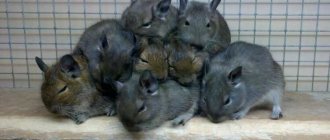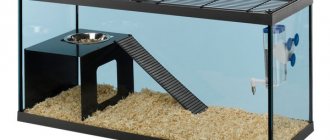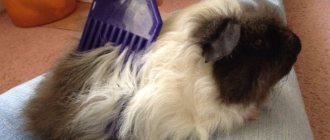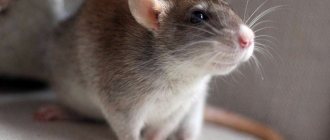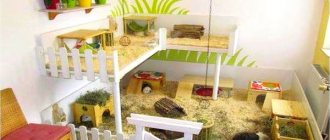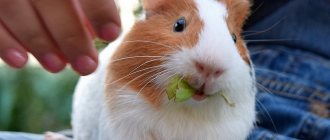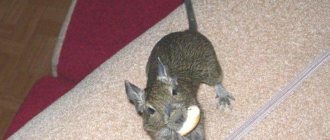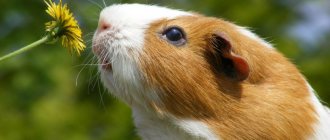Before purchasing a Chilean degu squirrel, it is important to prepare in detail everything necessary to ensure comfortable conditions for its life support. Despite its small size, the animal requires a large amount of free space. Squirrels love to move a lot, play and be interested in the world around them.
The aviary industry puts on the market high-quality products at a high cost, which can be found in every store. You can save money and reproduce a degu cage with your own hands. The project does not require large investments.
The price of the issue is the minimum cost. If you wish, you can search the Internet for advertisements of those who want to give away the cage for free.
What kind of cage does a degu need?
Despite the fact that the degu is a rather small animal, it needs a very spacious cage. Do not forget that in natural conditions they move around a lot and maintain this activity while in captivity. They need to climb on multi-level structures and run a lot. Therefore, the home must meet the following criteria:
, 1 m long and 0.6 wide. It’s good if the house has a 1x1m pallet and a height of 1.5 - 2m. Then the pet will have a lot of free space for an active lifestyle.
Dimensions no less than 1.2 m in height- Dense pallet . It must be made of durable, high-quality material. Otherwise, the squirrel may chew through the bottom and escape.
- Only environmentally friendly materials . Degus tend to chew the cage and all its contents. This does not mean that the animal does not like something, it is just its peculiarity. If some elements are covered with paint or other chemical compounds, the animal may simply be poisoned.
- Durable lock . Squirrels are smart animals. They learn to open simple locks fairly quickly, so make sure you have a good door and a strong lock that won't be difficult to open.
- Tight fixation of components . Degus literally run around the cage. And if it is poorly put together, they can simply demolish their house. Especially if you have a couple or several pets.
- Filling . Animals need additional elements: a wheel, a hammock, a house, shelves, etc. They will not be able to actively live in an empty cage, so take care of the animals’ comfort.
Be sure to take into account the above conditions, only then start building the cage.
Specifications
Creating a cage is a responsible and labor-intensive process that requires a qualitative analysis of the animal’s preferences. All materials must be durable and completely safe, since in any opportunity the degu will try to chew on the rods.
It is acceptable to use aluminum or galvanized equipment. It is strictly forbidden to use chemicals containing glue or sealant. The animal may become poisoned.
The most optimal cage size for a Chilean degu is 1.2*1*0.6 m. The dimensions allow you to house up to five adult degus. Experts do not recommend keeping pets alone.
Degus endure extreme stress, which can affect their health in the long run. The arrangement of a degu cage must be planned in advance.
What can you use to make a degu cage?
We have already mentioned that it is better to take only environmentally friendly materials. Each of the components of the cell can be made of the following materials:
- the bottom can be made of clapboard;
- the basis is made up of durable, non-resinous beams;
- the walls from plexiglass or galvanized mesh.
Place a dense bedding of hay and filler on the bottom, and additionally reinforce it with mesh or plexiglass. This will prevent possible escape if the floor is chewed through. Also, do not forget that before use the wood must be treated with an antiseptic.
Important! Wood treatment should be carried out every six months.
Features of the showcase
Most breeders are accustomed to the fact that all rodents, like most other pets, are kept in cages. The advantage of such a structure is that it is easily ventilated, illuminated and keeps the animal safe.
A degu showcase is a spacious enclosure equipped with glass and an adjacent frame. In order for air to circulate throughout the entire area, it is necessary to add ventilation and lighting. The wires must be located so that the animal cannot reach them under any circumstances.
Squirrels love to chew on everything they see. In order to preserve the integrity of the house and wooden structures outside its area, it is recommended to cover the edges with a special aluminum tape. Before putting the squirrel inside, the cabinet must be well ventilated.
Acrid odors can cause allergic reactions or stress, as Chilean squirrels have a very keen sense of smell. Most often, equipment is made to order, based on the characteristics of the room in which it will be located.
You can also make a wonderful showcase for degus from old unnecessary furniture. The following options are listed that can be a good alternative to a glass enclosure:
- bookshelf;
- sideboard;
- chest of drawers with glass.
In order to create a spacious, convenient display case from a cabinet, you need to study the following algorithm of actions:
- all shelves and walls of the cabinet must be wiped from dust and dirt;
- make a glass hole for the light bulb. Cover the wires securely;
- create ventilation;
- On each side panel, runners are installed, delimiting the display case into several floors. Sticks and ladders are attached to each of them;
- A dense bedding of hay and wood shavings is placed on the bottom of the enclosure. The house is not installed;
- the upper floor acts as a dining area. Feeders, drinking bowls and other treats are placed there, depending on the number of rodents;
- the remaining floors are used for recreation, games and other leisure activities.
Such an enclosure will be a wonderful home for Chilean squirrels. You can do it yourself. Each floor is distributed according to its purpose. There will always be fresh air and sufficient lighting in the display case. If desired, the design can be supplemented with everything necessary.
Step-by-step instructions on how to make a degu cage with your own hands
To imagine what the finished cage will look like, you can visit different pet stores and look at the products on offer. Also look at the work of other artists.
Important! The size of the cage is selected depending on the number of pets - the more pets, the larger the house should be.
Preparatory stage
You need to start with a drawing. If you are an experienced craftsman and have a trained eye, then you can skip this step. But it’s better to make a drawing indicating all the dimensions and the amount of material needed. If you do not want to create a drawing yourself, use the proposed model.
After the drawing is transferred to paper, start preparing the necessary tools and materials.
You will need the following materials:
- nails;
- self-tapping screws or self-tapping screws;
- lining;
- wooden blocks;
- galvanized mesh;
- lock on the door.
Tools also needed:
- hammer;
- screwdriver or drill;
- hacksaw;
- metal scissors.
Make blanks based on existing drawings. Also indicate all dimensions and quantities in the drawing, and be guided by it when preparing for work. Once all the elements are ready, you can begin assembly.
Assembly
Assembly is carried out gradually, from bottom to top.
- First, assemble the bottom: make a base from wooden blocks and make a bottom from clapboard. Screw the bars with screws or self-tapping screws, so you can create a reliable base for the cage.
- Then make three walls. Screw the mesh to the base, and gradually make all three walls. For greater strength, you can make one wall from lining. Plexiglas is also a good option, in this case you will prevent the contents of the house from scattering outside.
- Separately, make another wall with a door. And leave it for now.
At this stage, it is worth taking a break and doing some internal arrangement.
Important! At first it makes only 3 walls, the fourth is placed only after the cell is filled.
If you do all the walls at once, it will be inconvenient to fill your home with various elements.
Filling
So that the animal can fully realize the need for activity, make a cage in several tiers, and place various objects inside. Among them the most suitable:
- shelves;
- thick branches;
- hammock;
- you can hang a rope along which your pet can climb to other floors;
- be sure to make a house;
- screw on the wheel (it’s easier to buy it ready-made).
Design the cage with love and care for your pet. Don’t be lazy once again to sand a sharp corner or prepare another shelf. But remember that you also cannot overdo it with filling - there should be a lot of free space in the home for comfortable movement.
join the discussion
Share with your friends
Degu or Chilean squirrel are incredibly cute fluffy animals with high mobility, are easily tamed and trained in various actions. In the wild, a degu's natural habitat revolves around a series of endless burrows. In fact, wild degus have been observed to form what researchers call "linked tunnel digging" to create an interwoven network of underground burrows, the degus working in a coordinated manner.
In these homes, animals can safely care for their young, rest, eat and communicate. Therefore, when caring for a degu in captivity, it is important to choose and equip exactly the cage, house, display case, terrarium, enclosure that will contain all the amenities your pet needs to become a happy and healthy member of your family.
The simplest option
To build a squirrel’s home, it is recommended to use a ready-made drawing , which is presented below.
This option does not require special construction tools or carpentry skills. To start building a house, you will need:
- wood hacksaw;
- measuring tape and pencil;
- screwdriver and screws;
- jigsaw for cutting out a round entrance;
- any lumber;
- sandpaper;
- first aid kit in case of minor injury.
Measure a 55x30 cm rectangle on the board and cut it out - this will be the back wall of the house. The second rectangle (50x30 cm in size) is a blank for the front side.
The two sides of the ribs will be 55x30 cm in size so that the roof of the house is at an angle to allow water to drain after rain.
The upper and lower planks are cut out measuring 30x30 cm, one of them will be the roof, and the second will be the bottom.
When creating an entrance to a house, you need to draw a circle with a diameter of about 8 cm on one of the side surfaces. The hole should be located closer to the front and top surface . The entrance must be cut out with a jigsaw and be sure to sand it.
The walls must be fastened together in the following order:
- Align the 50 cm front wall with the side panel and fasten it with self-tapping screws; on the other side, attach the second side panel with the inlet hole.
- Attach the 55 cm back wall to the side panels. Use three screws on each side.
- Attach the bottom of the house from below by screwing one screw into each corner.
- Before attaching the roof, sand down any rough areas. You can lay straw or shavings on the bottom to make the squirrels more comfortable.
- It is best to attach the roof to the back wall with door hinges so that you can clean up the house if necessary.
- Place a small porch measuring 30x5 cm under the entrance hole.
- We need to think about a system for attaching to the tree. You can drive two nails into the tree trunk, and attach rings to the back surface of the roof of the house and hang the structure from them.
- To attract new residents to the house, you need to leave a few nuts, acorns, and seeds on the porch and inside.
Cell
Degus require a lot of space. Choose the largest cage with a hard bottom and place it in a dry, draft-free room away from direct sunlight. The height of the house is as important as the length and width. Degu loves to climb. If the cage has different levels, the shelves should be covered with untreated wood so that the degu does not injure its legs. Cover the floor with specialty bedding such as aspen or pine shavings, recycled paper or corncob bedding. Do not use cedar shavings, which contain harmful oils.
You can purchase or make a degu house like a birdhouse, that is, a box made of untreated wood or an old cardboard box that your pets will happily chew on. It is better to offer degu food in a ceramic bowl and fresh water in a bottle.
Degus need a lot of exercise and stimulation, so it is important to provide them with a variety of toys. A large exercise wheel is a great choice.
Many degus like metal wheels with crossbars, but you need to carefully monitor your pet to make sure that he does not injure his legs. The branches of a maple or fruit tree will help you to climb to the height of the degu pleasantly and comfortably. A large, deep box filled with soft, sandy soil provides a place to dig.
Cardboard or wood is a favorite material that degus love to chew; by the way, this is what helps them keep their teeth in shape and grind them down correctly.
Keep your degu's habitat clean by removing dirt and debris daily.
Once a day, you should thoroughly clean your glass or plastic water bottle. You need to wash the dishes and the bottom of the cage once a week. After rinsing the cage, it needs to be completely dry before adding shavings to the bottom.
Small tricks ↑
- You can use anything: any old boards, boards from packing boxes, slabs - as long as it is natural wood.
- All material for production must be dry.
- The optimal board thickness is 2-2.5 cm. In this case, the house will last a long time.
- There is no need to plan the boards for the inner walls of the squirrel cage.
- The width of the side panel should be 30 cm, and the front and back should be 25 cm. We have already indicated all other parameters above. This is done for the convenience of the squirrels, because they will not live in too large dwellings.
- It is better not to nail the bottom of the squirrel cage from the outside, but to place it inside - this way it will not fall out and will serve for a long time.
The simplest squirrel hut made from boards may be liked by the animals more than an ornate store-bought house
Belchatnik can be made in two ways:
- put together from boards, like a birdhouse;
- hollow out from a solid log.
Health
If you want your pet to remain healthy and active, you need to choose a cage that is wide and fairly tall so that not only a wheel can fit in this house, but also ledges for climbing, a hammock or sleeping mat, treats, food, shavings and other necessary toys and accessories. A plastic tray is considered an excellent solution for the bottom of a cage with metal bars.
Most cages designed for chinchillas and other rodents will work just fine. You should avoid small plastic parts as your pets will chew them.
Before choosing a cage, first make sure you research the dimensions you need in detail and choose the right accessories to ensure you've considered every option. For example, if there is a moving part in the installation that could potentially catch your leg, tail, or neck. Will a degu be able to chew the bottom of the cage? In general, all materials from which the cage or toys are made must be non-toxic. The lock on the door to the house must close securely.
Finally, when comparing ideas and plans for choosing and creating a degu house, resist the temptation to use an aquarium. Even the largest aquariums will not provide the right type of ventilation or layout that will support a multi-level habitat that your pet will truly enjoy.
Equipment for rodents
Arranging a degu cage requires special attention. It contains drinking bowls, feeders, a house, a “bathhouse” and toys. Items can be purchased in the store. Stainless steel bowls are used as feeders. They are fixed to the walls or to the frame. It is recommended to use nipple drinkers. A manger is used for hay.
There should be several houses. Sometimes squirrels sleep in the same house, hugging each other. In this case, you can make a “bathhouse” from another shelter, which is necessary for the animals to bathe. Choose wooden or ceramic structures. A stump without a core, wooden labyrinths, straw structures can serve as a shelter for rodents:
It is necessary to create comfortable living conditions for degus. The cage is made spacious, multi-tiered with stripes and transitions. Filler is placed on the floor. This will help avoid corns. All dirt will collect in the pan, but it is protected from the teeth of a rodent. The health of the Chilean squirrel depends on how spacious the home is.
YouTube responded with an error: The request cannot be completed because you have exceeded your quota.
Source
Cage installation
These animals are social animals, and when they have at least one more degu in their houses, they are simply happy. Your pets love to communicate, so don't leave them unattended. By the way, they can often start chatting excitedly or even grumbling nervously, and this cannot but touch you. The average lifespan of these animals is 5-10 years. Before you get these cute furry animals, consider the following.
- The degu will constantly need nutritious food, fresh fresh water and a clean habitat.
- Degus need daily exercise and play. All members of your family should understand how to keep a pet.
- Degus are social animals, so you need to constantly communicate with them and pay attention to them.
- Of all rodent species, degus require more free space.
“New building” for a squirrel: the purpose of construction
House for several squirrels
Rodents can live in a self-constructed house all year round, and they will feel comfortable, safe and well-fed, especially in winter, when there is no urgent need to look for food.
Therefore, you can observe their interesting behavior and feed them with nuts whenever possible.
Psychologists have proven that contact and observation of small furry animals causes positive emotions in a person; as they say, relaxation occurs.
A house for a squirrel is:
- food storage
- area for the birth of baby squirrels
- reliable protection in cold weather
In addition, a home for a furry animal, made independently, is a worthy decoration for any park.
By creating a squirrel colony, this is not only helping our smaller friends, but also fulfilling the main mission of man on earth - to make the world more beautiful.
Basic items that should be in the cage
A free cage must be equipped with a hard bottom. It must be covered with shavings. There should be a bowl of food and a bottle of water. Food for your animal can be selected from food for guinea pigs or pellets for chinchillas. The arrangement of the cage includes not only important objects for climbing or feeding, the existence of objects that the degu will chew is considered mandatory.
The exercise wheel should be selected as hard as possible.
Wheel
The degu cage should be equipped with a wheel, which the animals love to spin. It is better to make such a structure from metal or organic glass. You can cover the wheel with fabric to make the paws of rodents more comfortable. This will also prevent the formation of corns.
The main condition in the design of the wheel is the integrity of the treadmill. If there are gaps or crevices, the degu's tail could get caught in there, causing injury.
The size of the wheel for animals must be at least 20 centimeters in diameter.
Additional items
In addition to the basic items and accessories that should be in the cage, for a healthy and active life the degu will need additional accessories:
- hay rack;
- beautiful frame made of untreated wood;
- place for digging holes;
- hammock;
- tree branches without pesticides.
Sand for bathing
Degus need to regularly take sand baths to cleanse their fur of sebum and to get rid of excess moisture. Any container can be used. It is recommended to place a bathing suit in the cage every day, but you can reduce the number of such baths to two or three per week. The container should not be kept in the enclosure all the time, because it will quickly fill with garbage, and the degus will use it as a toilet.
Ordinary sand is not suitable for these animals. It is too rough for them and can damage their delicate skin. Therefore, you should purchase a special mixture for bathing chinchillas at a pet store.
Source
Appeal
Most degus should be treated with extreme caution. If you want your animal to remain tame, you need to communicate with it and pick it up daily. You need to insert your hands into the cage carefully and slowly so as not to frighten your pets, and so that your sudden movements are not perceived by the degu as aggressive actions of predators. Let the degus come up to you, first they will sniff your hand, then they will be able to eat from your hands, and then they will easily climb up to you.
Never pull a degu out of its cage by its tail!
Requirements for the feeder
A feeding trough, as well as a house for furry beauties, must be made in accordance with certain rules:
- For a do-it-yourself squirrel feeder, only natural wood is used, and not varnished chipboard or even plastic fragments. Firstly, squirrels live in the forest and all kinds of paints, laminates and plastic paraphernalia are extremely dangerous for a delicate organism. Secondly, the smell of varnish can scare away the squirrel and your work will be in vain.
- You need to make a compact structure.
- If the feeder is closed, then it needs a round hole.
- In order for squirrels to visit the feeder, you need to hang it correctly - only on a tree, and at such a height that you can safely put food and treats there.
General care
Regular exercise outside the cage is essential for the health of your degu. The room in which your pet will live should be made as safe as possible. For example, it is imperative to prevent access to electrical cords, remove all dangerous objects and block access to furniture and appliances. An excellent solution is to use a playpen for degus to spend time outside the cage. Your pets will be completely safe here. Never leave a degu outside its cage unattended.
Diet
The best food for feeding degus is guinea pig or chinchilla food. Sugar is not suitable for degus to eat, so you need to check the list of ingredients on the food packaging. Dried fruits or molasses should be avoided and not added to your pet's food. Fresh hay must be available at all times. You need to supplement your pet's diet with fresh vegetables, but not fruits, which have a high content of natural sugar. You can try offering your furry animal seeds or puffed rice.
For information on what a degu cage should be like, see below.
Product installation
As in the case of a birdhouse in the country, a house for a squirrel can be secured to a tree with special clamps or wire . Also, it can be stuffed onto a dead part of the tree so as not to injure it. It is advisable to do this in more or less dense vegetation, without turning the front towards noisy places, so that the animals feel some kind of security.
It is better to install the squirrel house higher, at a level of 3-6 meters, but do not forget that working at height can be dangerous, and therefore, be sure to use insurance.
What kind of cell should it be?
Despite the fact that degus are very similar to a hamster or a squirrel, their living conditions require special comfort. If the family has decided to buy such an animal, then first of all you need to prepare everything necessary so that the degu feels calm. You can buy a ready-made house for your pet, but it will cost a pretty penny. Therefore, such a structure can be made with one’s own hands, and even a woman can cope with the work.
Before choosing a design and materials for creating a cage, it would be a good idea to familiarize yourself with the requirements for such a design:
- degus like to run a lot, so their house should be as large and spacious as possible, it is even advisable to build a 2 or 3-tier building;
- you need to give preference to strong material, since such animals like to chew a lot, which is why all objects, including pallets and walls, can quickly become unusable;
- the sides and protrusions are protected (for example, made round), otherwise the degu will cling to them with its teeth, which increases the risk of injury to the pet;
- minimum cage dimensions – 1.2x0.6x1 m;
- It is advisable to keep animals in pairs (if there is no desire to breed, then same-sex rodents are taken), so there should be enough space for both of them;
- since these squirrels are very small, the width of the rods in the wall should not exceed 1-1.5 cm, otherwise the pets will quickly scatter around the house, especially when the babies are born;
- babies need to rest, so the cage should have long shelves for sleeping and a couple of short ones for playing;
- the cage tray must be made of a very dense material, since there is a possibility that it will be chewed through and simply run away, and this is not to mention the fact that the material itself can lead to problems with the gastrointestinal tract of the animal;
- when constructing a structure yourself, it is important to tightly fix all the parts together, otherwise active degus will simply destroy the cage;
- the side walls are a barrier for pets, so to create them you will need a fairly strong material - if it is not organic glass, then reliable wire or galvanized mesh (degu teeth easily bite through thin metal);
- the arrangement of the door should be approached with special care, since such rodents are very playful and active, so when they are taken out of their cages they can jump out;
- it is advisable to place the doors higher and close them with a carabiner, since degus quickly learn to open the simplest devices, for example, in the form of a hook;
- if metal is used to create the cage, then you should give preference to chrome-plated products rather than painted ones, otherwise the animal may be poisoned by the chewed paint;
- when working with plexiglass or getinaxem, it is necessary to create additional holes in the walls, otherwise there will be no circulation of fresh air and the animal will simply suffocate;
- the cage must have 10 cm of bedding, since such rodents like to bury themselves in the sand.
Having familiarized yourself with all the above requirements, you can begin building the cage.
What can you use to build a degu house?
Not only the beauty of the house, but also its durability will depend on the quality of the material. It is worth understanding that degus love to taste everything. Therefore, the walls and hem must be reliable and in no case harm the animals.
Acceptable materials for the cage are aluminum, plexiglass, clapboard or galvanized mesh. But for such purposes, in no case should you use fiberboard, chipboard or other wood-based material, since gnawing an element can cause poisoning to a rodent. This applies not only to walls and pallets, but also to other “interior” items.
When it comes to creating a cage, it's best to start with a drawing. The size of the house directly depends on the number of residents and the plans of the owner. For example, if only a same-sex couple will live there, then there is no point in constructing a three-story “building.” But when you plan to breed degus, children will need more space than adult animals. You also need to take into account the fact that all the plastic parts that will be inside will remain untouched for a long time. Therefore, the owner should have the opportunity to freely carry out “repairs” from time to time, and not just change the pallet.
As for creating a cage, the easiest option would be to make it from galvanized mesh. The work looks like this:
- First, a frame is created from the beams. For fastening, you can use nails or self-tapping screws, but the latter will ensure a tighter fixation of the elements. The wood must be non-resinous and well dried.
- Next, the rear wall is decorated with clapboard. It is important to ensure that when attaching the sheets there are no gaps, otherwise the animals will be able to leave their home. Screws are suitable for fixation. The floor is also lined with the same material.
- To create the side walls, galvanized mesh is used. Cell size – 2x2 cm, no more. Depending on the shape of the cage, you need to mark the location of the future door and cut a hole using metal scissors.
- The top of the cage is also decorated with the same galvanized mesh. For ease of transportation, a handle can be fixed on the top.
- To make the animals comfortable, such a house needs to be equipped with entertainment elements. The first step is to take care of the shelves for rest. For such purposes, non-resinous wooden blocks or plywood are used. For a couple of residents you need to make 3 long and 4-5 short shelves where they can relax. On the same elevations you can place houses, a labyrinth, a wheel, etc.
- The last step is installing the door. It’s worth saying right away that to close it you need to use a lock or carabiner. Degus are such smart animals that they can literally learn to open a hook in just a couple of days.
Making a simple squirrel feeder
You can make a regular squirrel feeder from available materials in literally 1 day. The sequence of actions will be as follows:
- Create a project and drawing of the house, which accurately takes into account the ratio of the sizes of all parts: the bottom, side walls and roof (you can also make the back wall and shelves).
- Choose a material for the house - a dry wooden board is ideal.
- Transfer all the details to the board using a pencil and ruler; cut them out carefully.
- Fasten all parts with nails or self-tapping screws.
- Secure the feeder to the tree using strong wire or clamps.
Reviews
Anna Koteeva, 32 years old, Kropyvnytskyi
For our daughter’s fifth birthday, my husband and I decided to give her a gift – a degu. Since our apartment is not large, my husband decided to use the niche wisely, where they placed a house for the pet. We did not buy a ready-made cage, since they are not very cheap, and despite the fact that houses for hamsters or rats are not suitable for the Chilean squirrel. Therefore, the husband himself made a cage from plexiglass on one floor. Since we knew that such animals live in pairs, we gave the baby 2 degus. Imagine our surprise when a year later one “boy” brought us offspring. As a result, the husband had to finish 2 floors and another house, since it turns out that until the babies grow up, the males need to be kept separately. I would also like to add that such rodents need their own houses, that is, one housing per individual. Otherwise they fight.
Timofey Kolt, 51 years old, Uman
I work in a pet store and they often buy Chilean squirrels from me. When a buyer purchases an animal, he tries to buy everything necessary for it. Unfortunately, cages for such rodents are not very cheap, so many people simply buy furnishings for them, making the house themselves. And here not everyone doesn’t know that baby degus need their own corner. I make cells for sale myself, so I want to give one piece of advice. Since such animals do not like direct sun, they need a place where they can hide from it. If it is not possible to buy a ready-made house, then you can simply cover one of the corners with thick dark fabric.
Kristina Lebedeva, 24 years old, Moscow
My beloved gave me a degu on February 14th. We made the cage ourselves. I insisted on plexiglass, as it is easier to fit into the interior. I paid special attention to the comfort of pets. Therefore, having studied a lot of literature, I want to give a couple of tips. Degus secrete a lot of liquid, which is why we change the tray almost every day. Once every 3-4 months, my boyfriend makes me new wooden shelves, as they absorb moisture very strongly and begin to smell unpleasant. Also, so that my little ones wouldn’t get bored, I sewed a hammock myself and hung it on the “2nd floor”. When I first set up the cage, I bought ordinary rodent houses for them. Literally by the second month, they no longer resembled anything. So then I bought them a home made of pine needles. It turns out that this breed is absolutely safe for degus, but it tastes bitter, so they don’t touch the houses anymore.
